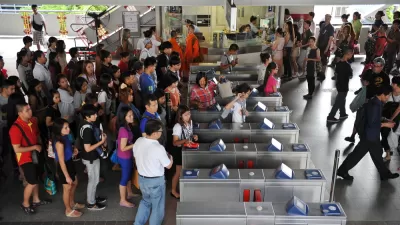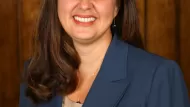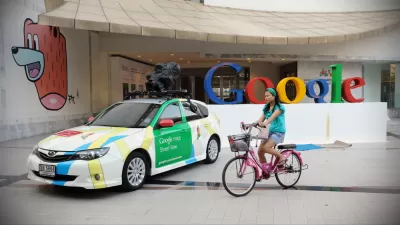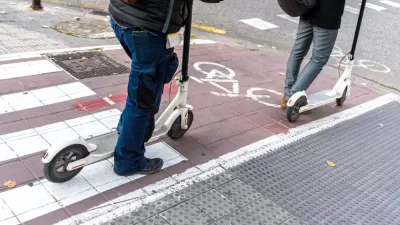Imagine on your phone being able to wake up and with a simple click be able to arrange all of your transportation needs for the day. Soon your bus pass, carsharing pass, bikesharing pass, and your personal vehicle will go away—replaced by an app.

A commute today can involve a number of different modes of transportation. For example, you might walk to the bus stop and take the bus to your office. At lunch you use the city's bike sharing service to bike to lunch to meet a friend. After work you use a car sharing service to run to the grocery store before heading home. To undertake this travel throughout the day you would need a bus pass, bikesharing pass, and carsharing pass. In the future you may just have one pass that covers all of your transportation options—known as Mobility as a Service or Mobility on Demand. An easy way to think about this is as the internet of moving things—that is using our smart devices to get places.
Dr. George Hazel, a Smart Mobility Network Integrator at Scottish Enterprise, discussed the future of Smart Mobility. Companies, such as Ford and BMW, are increasingly seeing themselves as mobility providers rather than vehicle manufacturers. Companies are now partnering to create better experiences. "Mobility as a Service" intends to meet customer’s transportation needs through one interface and offered by one service provider. Transportation services are bundled into a mobility package giving residents flexibility to choose the suite of transportation services that best meet their needs.
Helsinki aims by 2025 to have a system where there no reason someone would need to own their own car. The system would allow people to purchase mobility in real time from their smart phone. The intent is to provide an array of transportation options that are inexpensive, flexible, and well-coordinated so that it becomes easier to use, more convenient, and more cost effective than owning a car.
More than a year ago, Helsinki launched Kutsuplus, which lets riders specific their desired pickup and drop off points on their smart phone. These requests are aggregated and the app calculates the optimal route to get you from point a to point b. The cost is more than the bus but less than cab fare, and the result is on demand public transit service.
Similar to Kutsuplus, Bridj describes itself as a popup mass transit service operating in Washington D.C. and Boston. Bridj is a mobile app that allows users to specify where they want to go and when they want to leave. Users reserve a seat and then go meet the Bridj bus.
Soon we will move beyond on demand transit to mixed mobility services. Finland is moving to Mobility as a Service. Twenty-three organizations are coming together to operate collectively to allow people to easily choose and pay for a mix of transportation modes. With the Mobility as a Service model, users easily combine transportation options for a seamless trip.
The United States will likely soon follow. Daimler recently acquired Car2Go, a car sharing service, and the trip planning smartphone app (RideScout). This is indicative of key components of a successful mobility-as-a-service future.
For planners the optimization of our transportation systems could be substantial. With mobility as a service there is the opportunity for greater flexibility and reliability than can be achieved with transportation systems today. In addition, it could substantially reduce the demand for parking. How could mobility as a service change transportation in your community?
This is another installment in a series covering Cities and Citizens in the Digital Age.

Maui's Vacation Rental Debate Turns Ugly
Verbal attacks, misinformation campaigns and fistfights plague a high-stakes debate to convert thousands of vacation rentals into long-term housing.

Planetizen Federal Action Tracker
A weekly monitor of how Trump’s orders and actions are impacting planners and planning in America.

In Urban Planning, AI Prompting Could be the New Design Thinking
Creativity has long been key to great urban design. What if we see AI as our new creative partner?

King County Supportive Housing Program Offers Hope for Unhoused Residents
The county is taking a ‘Housing First’ approach that prioritizes getting people into housing, then offering wraparound supportive services.

Researchers Use AI to Get Clearer Picture of US Housing
Analysts are using artificial intelligence to supercharge their research by allowing them to comb through data faster. Though these AI tools can be error prone, they save time and housing researchers are optimistic about the future.

Making Shared Micromobility More Inclusive
Cities and shared mobility system operators can do more to include people with disabilities in planning and operations, per a new report.
Urban Design for Planners 1: Software Tools
This six-course series explores essential urban design concepts using open source software and equips planners with the tools they need to participate fully in the urban design process.
Planning for Universal Design
Learn the tools for implementing Universal Design in planning regulations.
Appalachian Highlands Housing Partners
Gallatin County Department of Planning & Community Development
Heyer Gruel & Associates PA
Mpact (founded as Rail~Volution)
City of Camden Redevelopment Agency
City of Astoria
City of Portland
City of Laramie






























